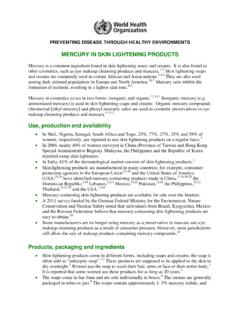Transcription of of Field Parameters - Pure Water Forum
1 William G. Maddox p y g Environmental Specialist II, Valley Regional Office Department of Environmental Quality 4411 Early Road, Harrisonburg, Virginia Office: 540 574 7831. Office: 540 574 7831, FAX: 540. FAX: 540 574 7878. 574 7878. Web: M il P O B Mail: Box 3000, Harrisonburg, Virginia 22801. H i b Vi i i 8. List of Field Parameters Dissolved Oxygen pH. Total and Free Residual Chlorine Temperature (Turbidity not a common effluent limitation.). Note: Flow rate is a measurement, though not obtained using a Water sample analysis. It is an effluent bt i d i t l l i It i ffl t discharge characteristic or parameter. Regulation DEQ Mission Statement: DEQ protects and enhances Virginia's environment, and promotes the health and well.
2 Being of the citizens of the Commonwealth. being of the citizens of the Commonwealth Over 5,000 people die worldwide everyday from drinking or bathing in Water containing the same contaminants that are removed at wastewater treatment plants. Regulation Clean Water regulations accounted for benefits of up to $8 billion at a cost of $ to $ billion. Clean air regulations provided up to $163 billion in benefits regulations provided up to $163 billion in benefits, while costing taxpayers only about $21 billion. Regulation Bureaucratic red tape, the difficulty of finding information, lengthy training in g g y g regulatory requirements, having to y g g g y constantly revisit changing regulatory policy, and haphazard enforcement of the y rules may be an immediate concern but.
3 Regulation You have a stronger, fuller, more aware understanding of regulation than average and can see that . Your efforts support living in a clean and healthy ff li i i l d h l h Virginia environment, benefitting your family and avoiding health risks for you and others around you avoiding health risks for you and others around you. You can help others understand this. Regulation Testing is intended to be reliable, uniform, and accurate. (SM, Preface). (S P f ). We are considering Field testing and measurement of Water at the site where the sample was taken or nearby Water at the site where the sample was taken or nearby, not testing and measurement performed in an environmental laboratory.
4 Analysis is immediately or y y y within 15 minutes holding time maximum. Field testing term originated in testing military equipment under Field conditions. i d fi ld di i Field Testing Characteristics of the parameter dictate the equipment design and sampling (grab or in situ). The ideal design could obtain the same result from any h id l d i ld b i h l f such instrument of a test of a sample anywhere, every time No ideal instrument exists time. No ideal instrument exists. We do our best (hence method regulation, choices, and lots of care, and the dynamics of improvements). y p Field Test Be Aware of Individual Field Test Be Aware of Individual Variables Example a simple contact sensor like a thermistor for temperature (or liquid in glass or thermocouples and such): Measures its own temperature, so must be in equilibrium with the media it is contacting ( Water with the media it is contacting ( Water .))
5 No heat flow between them). Electrical properties are important (resistance, current p p p THERMal resISTOR). Water is dynamic with lots of possible variations in temperature (surface, depth, aeration, movement) ( f d h i ) Field Testing Four Basics Measure or sample for a representative result of the discharge characteristics di h h i i Follow approved method Follow instrument manufacturer's recommendations F ll i f ' d i Keep good records Field Testing You Know . VPDES Permit Part II A 2: Monitoring shall be conducted according to procedures approved under Title 40 Code of Federal Regulations Part 136 or alternative methods approved by the Environmental Protection Agency, unless other procedures have been specified in this permit.
6 Have been specified in this permit 40 CFR Part 136 . EPA Federal Register Guidelines Establishing Test Procedures for the Analysis of Pollutants Under the Clean Water Act; Analysis and Sampling Procedures y p g Field Testing Need initial demonstration of capability (IDC) available for each analyst/operator il bl f h l / performing f i analysis. SM 1020 For once per month analysis frequency or less, For once per month analysis frequency or less establish a set time each monitoring period for sampling and analysis. If that will not provide a sample p g y p p representative of the monitoring period, collect more samples/perform more analyses. Dissolved Oxygen Winkler (Azide modification).
7 SM 4500 O B 2001, C 2001, D 2001, E 2001, F 2001. ASTM D888 09 (A) USGS/AOAC/Other , I 1575 Electrode SM 4500 O G 2001 ASTM D888 09 (B) USGS/AOAC/Other I 1576 Luminescence Based Sensor ASTM D888 09 (C) USGS/AOAC/Other Footnote 63 Hach Method 10360, Luminescence Measurement of Dissolved Oxygen in Water and Wastewater and for Use in the Determination of BOD5 and cBOD5 Revision 1 2 October 2011 Hach Company. This method may be used to and cBOD5. Revision , October 2011. Hach Company This method may be used to measure dissolved oxygen when performing the methods approved in Table IB for measurement of biochemical oxygen demand (BOD) and carbonaceous biochemical oxygen demand (CBOD). Footnote 64 In Situ Method 1002 8 2009, Dissolved Oxygen (DO) Measurement by Optical Probe.
8 2009. In Situ Incorporated. Dissolved Oxygen Oxygen, Dissolved Probe Container G, Bottle and top Preservation None required Preservation Maximum holding time Analyze within 15 minutes. Winkler C t i G, Bottle and top Container G B ttl d t Preservation Fix on site and store in dark. Maximum holding time 8 hours. Use APHA type sampler (American Public Health Association specifications Displaces three times bottle volume without aeration). or analyze in situ (Latin literally in place ). Dissolved Oxygen Guides: Verify the accuracy of the temperature monitoring device on the meter at least annually over the operating range of the meter. Show calculations of correction factors applied for each recorded temperature measurement.
9 Be careful not to represent the temperature recorded as effluent temperature if the sample was not collected in accordance with effluent temperature monitoring procedures. Dissolved Oxygen Guides: Reactive compounds and gases (like hydrogen sulfide and other sulfur compounds) can interfere with the reading by reducing probe sensitivity for membrane probes (optical probes not affected by gases like hydrogen sulfide) probes not affected by gases like hydrogen sulfide). Measure after all treatment, including post aeration. Keep sensor in moist environment. p For the optical method, do not use organic solvents to clean the sensor but just wipe off any fouling gently with lens cleaning tissue.
10 Dissolved Oxygen Guides: The instrument, both electrochemical and optical, senses The instrument both electrochemical and optical senses the partial pressure of oxygen at the surface of the membrane, rather than the actual concentration of oxygen (weight/volume) The relationship between partial (weight/volume). The relationship between partial pressure and concentration is dependent upon atmospheric pressure and temperature when a reading is made in the air (i e during the air calibration procedure) made in the air ( , during the air calibration procedure), whereas, the equilibrium solubility of oxygen in Water is influenced by temperature, salinity, and pressure (of the gaseous phase).






